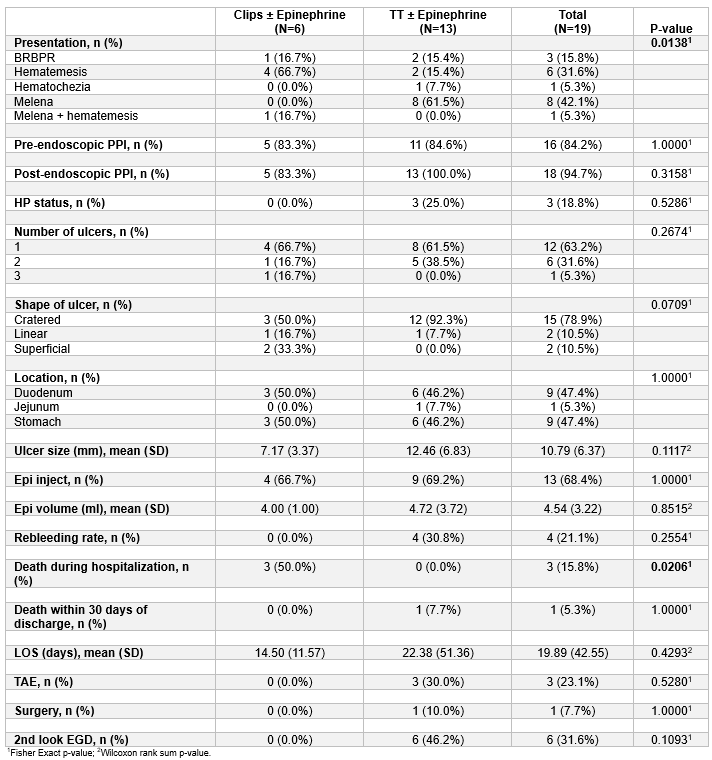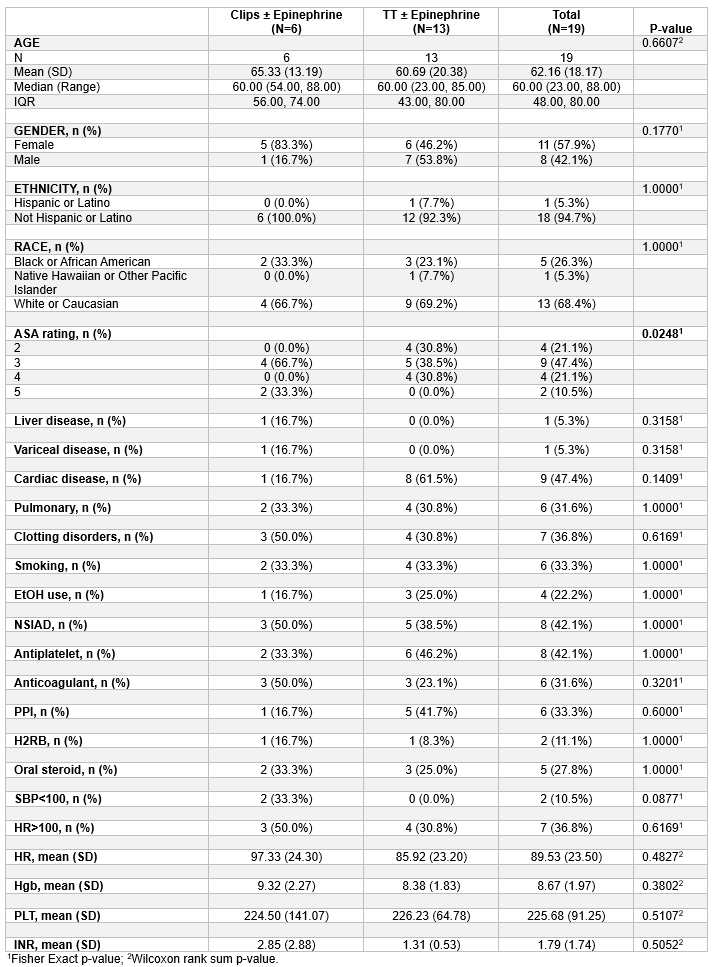Monday Poster Session
Category: GI Bleeding
P3049 - Clipping vs Thermal Therapy for Peptic Ulcers With Adherent Clots: A Pilot Study
Monday, October 27, 2025
10:30 AM - 4:00 PM PDT
Location: Exhibit Hall

Nurlan Aliyev, MD
University of Nebraska Medical Center
Elkhorn, NE
Presenting Author(s)
Nurlan Aliyev, MD1, Reif Megan, MD2, Jessica Larson, MD2, Abu Fahad Abbasi, MD3, Kelsey R. Wright, 2, Elizabeth R. Lyden, MS2, Alexander Hewlett, DO2
1University of Nebraska Medical Center, Elkhorn, NE; 2University of Nebraska Medical Center, Omaha, NE; 3Mercyhealth Gastroenterology Fellowship, Rockford, IL
Introduction: Peptic ulcer (PU) bleeding is a leading cause of upper GI bleeding. Adherent clots occur in ~7% of cases and carry a high rebleeding and mortality risk. The optimal endoscopic treatment—clipping vs. thermal therapy (TT)—remains unclear, and guidelines offer no specific recommendations. This pilot study evaluated outcomes of clipping vs. TT, with or without epinephrine, in patients with PUs and adherent clots.
Methods: This retrospective, single-center study was conducted at the University of Nebraska Medical Center database from 2015 to 2020. Adults (≥19 years) who underwent endoscopy for PUs bleeding requiring endoscopic therapy were included. Only cases with adherent clots were analyzed. Patients were stratified into two groups: clips ± epinephrine and TT ± epinephrine. The primary outcome was 30-day rebleeding after initial hemostasis, determined via chart review. Secondary outcomes included in-hospital and 30-day post-discharge mortality, length of stay (LOS), and need for hemostatic surgery or transarterial catheter embolization. The American Society of Anesthesiologists (ASA) classification was used to assess illness severity.
Results: Of 189 patients treated for PU bleeding, 21 (11%) had adherent clots. Two were excluded due to treatment discrepancies, leaving 19 for analysis: 6 in the clips ± epinephrine group (mean age 65 years, 83% female, 33% ASA 5 presented with hematemesis) and 13 in the TT ± epinephrine group (mean age 61 years, 46% female, 0% ASA 5 presented with melena). In-hospital mortality was higher in the clips ± epinephrine group (50% vs. 0%, p = 0.0206). Other outcomes, including 30-day rebleeding, LOS, and need for further interventions, were not significantly different (p > 0.05).
Discussion: In this pilot study, endoscopic clipping for PU with adherent clots was associated with significantly higher in-hospital mortality compared to TT. The higher severity of systemic illness in the clipping group (33% vs. 0% ASA 5) may have influenced this outcome. However, the contribution of clipping remains to be determined. These findings suggest caution when considering endoscopic clipping for PUs with adherent clots, particularly in females with hematemesis and higher ASA classification. Larger, prospective studies are needed to better define the role of endoscopic clipping in managing high-risk patients with adherent clots.

Figure: Study characteristics

Figure: Study characteristics and outcomes
Disclosures:
Nurlan Aliyev indicated no relevant financial relationships.
Reif Megan indicated no relevant financial relationships.
Jessica Larson indicated no relevant financial relationships.
Abu Fahad Abbasi indicated no relevant financial relationships.
Kelsey Wright indicated no relevant financial relationships.
Elizabeth R. Lyden indicated no relevant financial relationships.
Alexander Hewlett indicated no relevant financial relationships.
Nurlan Aliyev, MD1, Reif Megan, MD2, Jessica Larson, MD2, Abu Fahad Abbasi, MD3, Kelsey R. Wright, 2, Elizabeth R. Lyden, MS2, Alexander Hewlett, DO2. P3049 - Clipping vs Thermal Therapy for Peptic Ulcers With Adherent Clots: A Pilot Study, ACG 2025 Annual Scientific Meeting Abstracts. Phoenix, AZ: American College of Gastroenterology.
1University of Nebraska Medical Center, Elkhorn, NE; 2University of Nebraska Medical Center, Omaha, NE; 3Mercyhealth Gastroenterology Fellowship, Rockford, IL
Introduction: Peptic ulcer (PU) bleeding is a leading cause of upper GI bleeding. Adherent clots occur in ~7% of cases and carry a high rebleeding and mortality risk. The optimal endoscopic treatment—clipping vs. thermal therapy (TT)—remains unclear, and guidelines offer no specific recommendations. This pilot study evaluated outcomes of clipping vs. TT, with or without epinephrine, in patients with PUs and adherent clots.
Methods: This retrospective, single-center study was conducted at the University of Nebraska Medical Center database from 2015 to 2020. Adults (≥19 years) who underwent endoscopy for PUs bleeding requiring endoscopic therapy were included. Only cases with adherent clots were analyzed. Patients were stratified into two groups: clips ± epinephrine and TT ± epinephrine. The primary outcome was 30-day rebleeding after initial hemostasis, determined via chart review. Secondary outcomes included in-hospital and 30-day post-discharge mortality, length of stay (LOS), and need for hemostatic surgery or transarterial catheter embolization. The American Society of Anesthesiologists (ASA) classification was used to assess illness severity.
Results: Of 189 patients treated for PU bleeding, 21 (11%) had adherent clots. Two were excluded due to treatment discrepancies, leaving 19 for analysis: 6 in the clips ± epinephrine group (mean age 65 years, 83% female, 33% ASA 5 presented with hematemesis) and 13 in the TT ± epinephrine group (mean age 61 years, 46% female, 0% ASA 5 presented with melena). In-hospital mortality was higher in the clips ± epinephrine group (50% vs. 0%, p = 0.0206). Other outcomes, including 30-day rebleeding, LOS, and need for further interventions, were not significantly different (p > 0.05).
Discussion: In this pilot study, endoscopic clipping for PU with adherent clots was associated with significantly higher in-hospital mortality compared to TT. The higher severity of systemic illness in the clipping group (33% vs. 0% ASA 5) may have influenced this outcome. However, the contribution of clipping remains to be determined. These findings suggest caution when considering endoscopic clipping for PUs with adherent clots, particularly in females with hematemesis and higher ASA classification. Larger, prospective studies are needed to better define the role of endoscopic clipping in managing high-risk patients with adherent clots.

Figure: Study characteristics

Figure: Study characteristics and outcomes
Disclosures:
Nurlan Aliyev indicated no relevant financial relationships.
Reif Megan indicated no relevant financial relationships.
Jessica Larson indicated no relevant financial relationships.
Abu Fahad Abbasi indicated no relevant financial relationships.
Kelsey Wright indicated no relevant financial relationships.
Elizabeth R. Lyden indicated no relevant financial relationships.
Alexander Hewlett indicated no relevant financial relationships.
Nurlan Aliyev, MD1, Reif Megan, MD2, Jessica Larson, MD2, Abu Fahad Abbasi, MD3, Kelsey R. Wright, 2, Elizabeth R. Lyden, MS2, Alexander Hewlett, DO2. P3049 - Clipping vs Thermal Therapy for Peptic Ulcers With Adherent Clots: A Pilot Study, ACG 2025 Annual Scientific Meeting Abstracts. Phoenix, AZ: American College of Gastroenterology.
